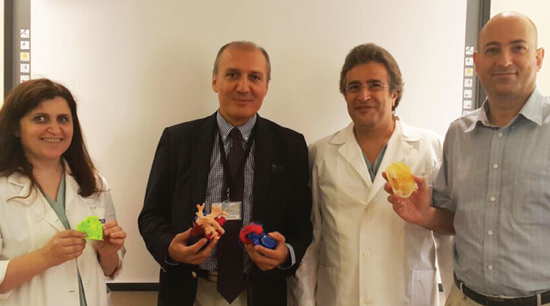
The Children’s
Heart Center (CHC) at the American University of Beirut Medical Center (AUBMC)
and in collaboration with the Department of Mechanical Engineering at the
American University of Beirut (AUB) introduced the 3D printing program in
complex congenital heart disease, a powerful supplement to aid in pre-surgical
planning for treatment, for the first time in Lebanon and the region. AUBMC has performed the first in-house model on
one of the CHC patients last month.
“3D printing is a technology that has
undoubtedly revolutionized medicine,” said Dr. El-Rassi, Chief of Pediatric and Congenital
Cardiac Surgery at the Children’s Heart Center.
“Its applications extend now to practically all the fields of healthcare.
Cardiac applications of 3D printing are becoming an integral part of
cardiothoracic surgery and interventional cardiology in children and adults.
Dr. El-Rassi added, “We have utilized this technology on our patient, and it
helped us to decide on the best treatment options.”
3D printing,
known as rapid prototyping or additive manufacturing, is the process of
creating solid, three dimensional objects from a digital file. The printer
deposits layers of a material such as plastic, resin or metal until the object
is complete Professor of Mechanical Engineering at AUB, Dr. Ramsey Hamade said,
“Three dimensional printing is a method for turning 3D computer designs and
sketches into physical models or even functional items that can be created
relatively quickly at minimal cost.”
“The 3D prints will help improve our decision
making in the treatment of complex CHD,” said Dr. Fadi Bitar, Professor and Director
of the Children’s Heart Center. Doctors can now conduct perfect procedures on
the model before surgical or cardiac catheterization intervention. Moreover,
the flexible physical models will better acquaint parents’ with the child’s
condition and improve medical students’ education.It will also
help parents and patients gain a better understanding of the complex anatomy of
congenital heart defects, in addition to identifying and describing the problem
that has been corrected or needs to be addressed.
Approximately
one in every hundred children is born with a heart defect. In many cases of
congenital heart disease, children will require at least one invasive surgery
throughout their lifetime. Dr. Rassi
highlights the importance of 3D cardiac models
in helping the clinician to decide on the surgical or interventional strategy
that best suits the individual patient and eventually has a strong impact on long term survival.
This groundbreaking program was initiated and led by CHC team: Drs. Issam El-Rassi, Fadi Bitar, Mariam
Arabi, and Georges Nemer, in
collaboration with Dr. Ramsey Hamade and Assistant Professor of Radiology Dr.
Lama Atweh, in addition to Mr. Charbel Saade. The 3D printing is an ideal way
to make a complete assessment and save the lives of many children with
congenital heart defects.
